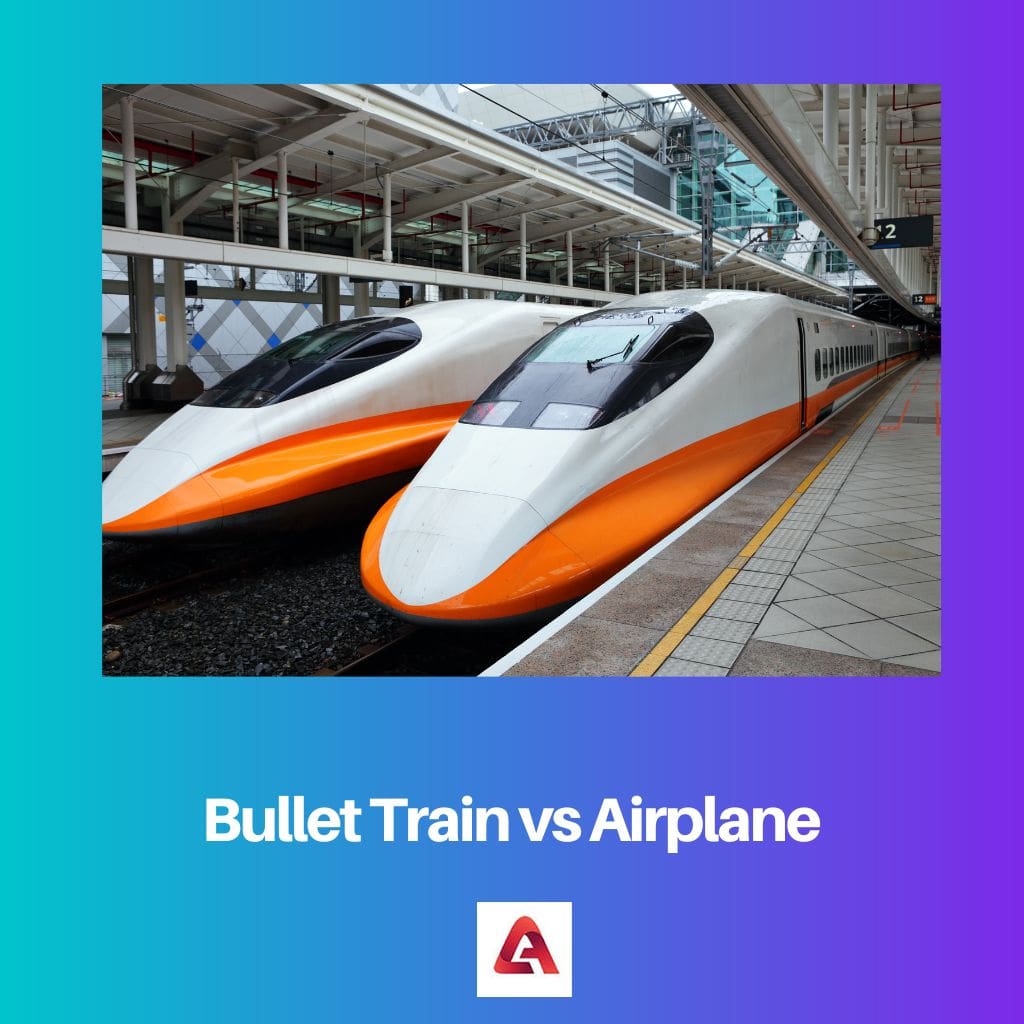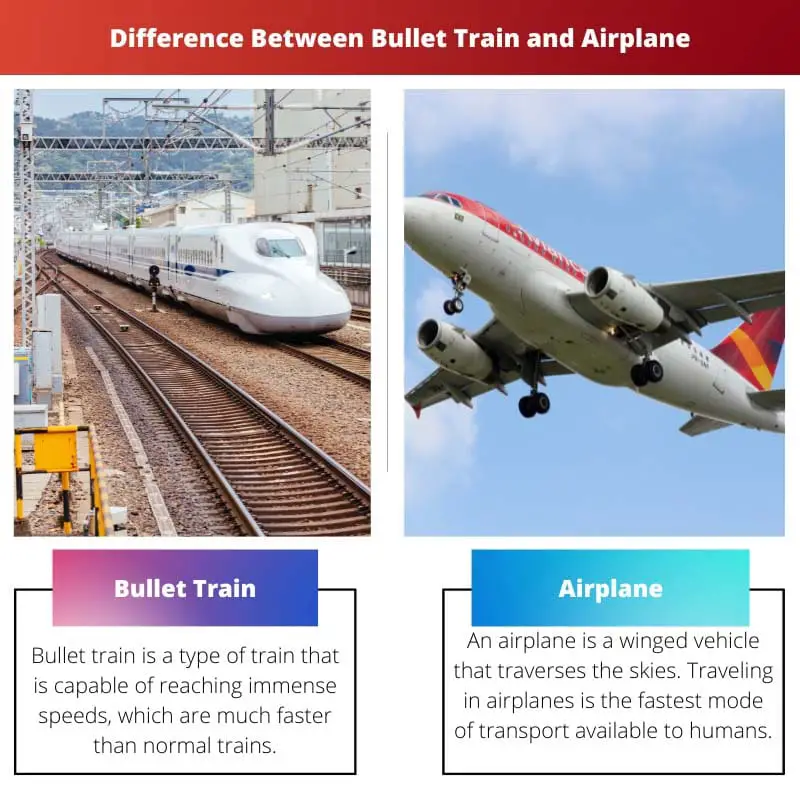We live on the surface of a huge planet. As primitive humans, it would have been impossible to traverse the kind of distances that we do today on a day-to-day basis.
The evolution of transport has made it possible for us to do so. Bullet trains and Airplanes are two such means of traveling.
Key Takeaways
- Bullet trains are high-speed rail systems that offer fast and efficient transportation between cities.
- Airplanes provide air travel, covering longer distances and connecting more distant destinations.
- While both offer time-saving travel options, airplanes are better for long distances, whereas bullet trains excel in shorter, regional travel.
Bullet Train vs Airplane
The difference between a bullet train and an airplane is that bullet trains are a means of rail transport. This means that while they can achieve immense speeds, the mechanism and the train itself use railway tracks to function. On the other hand, airplanes are a means of air transport.

Bullet train is a type of train that is capable of reaching immense speeds, which are much faster than normal trains.
The term “Shinkansen”, which is Japanese for the bullet train, is used to refer to the network of high-speed railway lines in Japan. Bullet trains have been functional for over 50 years in their home country of Japan.
An airplane is a winged vehicle that traverses the skies. Traveling in airplanes is the fastest mode of transport available to humans.
Airplanes use a complex understanding of jet or rocket engines that thrust them in the air, and a fixed-wing system that enables gliding and maneuverability in the machine.
Comparison Table
| Parameters of Comparison | Bullet Train | Airplane |
|---|---|---|
| Mode of Transport | High-speed rail | Air |
| Inventor | Hideo Shima | Orville and Wilbur Wright |
| Highest Achievable Speed | 600km/hr | Mach 3.3 |
| Utility | Transport | Transport, defense |
| Year and Place of Invention | 1964, Japan | 1903, Japan |
What is Bullet Train?
Bullet train is a type of passenger train that is capable of achieving very high speeds as compared to other modern trains.
While most trains that have petrol or diesel engines are capable of achieving speeds capped at 150-170 km/hr, bullet trains in Japan have a high speed of around 320km/hr.
The origin of the bullet train can be traced back to Japan in the 1960s. Due to its uneven terrain, jagged shorelines, and spread of the mountainous region, most of Japan had a narrow-gauge railway line.
This meant that trains could not even achieve speeds of 130km/hr for freight and transport. Thus arose the need for a high-speed railway line in Japan.
Hideo Shima is credited as the chief engineer of the world’s first-ever bullet train and its railway line, the Tokaido Shinkansen.
Unlike normal trains, bullet trains do not cover the entire journey on wheels. While they are not in motion, they rest on rubber wheels.
When the train initiates motion, it continues to move on these wheels up to speeds of around 150km/hr. While in motion, the train interacts with the magnets beneath them on the railway track.
After the bullet train achieves the threshold speed of 150km/hr, the magnetic force becomes strong enough to lift the train a few inches above the ground. Magnetic levitation thus eliminates friction, allowing bullet trains to achieve incredible speeds.

What is Airplane?
An airplane can be broadly defined as an aircraft powered by a rocket or jet engine with propulsion and has fixed wings. It flies in the air due to the action and force of air on its wings, and its propelled forward by the engines and propeller.
There were a few pioneers of aviation and aircraft building before the first airplane was even invented. In 1903, the Wright brothers, following the works of George Cayley, invented and flew the world’s first-ever airplane.
George Cayley had laid down the foundation of this invention with his notion of thrust and lift propulsion, and models constructed as early as the 1850s.
An aircraft, in straight unaccelerated motion in the air, has four forces acting on it at the same time, these forces being lift, drag, weight (due to gravity), and thrust.
Lift and thrust are forces created artificially by the engine and propeller to counteract the effect of the natural forces of drag and gravity to give flight to the machine.
The use of airplanes in their initial days was as a passenger vehicle in the air, eliminating road and rail traffic to immensely cut down the time taken for travel.
Today, airplanes are used for a variety of purposes, ranging from freight and passenger transport to defense jets and surveillance.
Technology has gone as far as creating unmanned aircraft as well as airplanes that cannot be detected by radar technology for espionage.

Main Differences Between Bullet Train and Airplane
- Bullet trains make use of magnetic levitation to achieve high speed. Airplanes make use of propulsion and lift to fly in the air.
- There are specially built magnetic railway tracks as bullet train guidance and propulsion system. Airplanes have engines and propellers that enable their flight and acceleration.
- Airplanes make use of special petroleum-based fuel called aviation fuel. On the other hand, bullet trains don’t run on fuel. They run on the forces of electricity and magnetism.
- Bullet trains are classified under high-speed railway mode of transportation while airplanes are classified under modes of air travel.
- China’s Maglev is the fastest bullet train with a maximum speed of 600km/hr. The fastest speed recorded on an airplane was the Lockheed SR-71 Blackbird at nearly 4000km/hr.

References
- https://link.springer.com/content/pdf/10.1007/978-3-540-46573-7.pdf
- https://ieeexplore.ieee.org/abstract/document/1222045/
